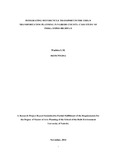| dc.description.abstract | The study focusses on motorcycle transport in Kenya with emphasis on integrating their
use and functioning in the urban areas in line with urban transportation planning.
Motorcycle transport industry in the country has been growing at a high rate (KNBS,
2013); which has not gone hand in hand together with modifications in standards and
policies and infrastructural considerations in transportation planning to try accommodate
motorcycle transport and allow it to work with other forms of transport.
This study was guided by the following objectives; to find out the existing operational
practices and opportunities of motorcycle transport, to find out the level of infrastructure
provisions for motorcycle transport along Thika Super Highway, to evaluate standards
and regulations established for enhancing motorcycle transport on the Super Highway;
and to recommend a strategies for integration of motorcycle transport to existing public
transportation system along development nodes on Thika Super Highway.
The study adopted a non-experimental research design. A sample size of 82 motorcyclists
was interviewed and the questionnaires analysed. Data was also collected using
observation and key informant interviews. Simple random sampling and purposive
sampling were employed in this study.
Some of the areas looked into by this paper include the operational practices of
motorcycle transport, the legistlation and standard that govern motorcycle transport and
the infrastructural provision in place.
The study highlights findings that include the lack of and need for infrastructure provision
for motorcycle transport, a gap in the standards and legislation in place and also
highlights various opportunities in the operational practices of motorcycle transport.
The study provides various recommendations to include the revision of the Traffic Act,
utilization of the existent societies and motorcycle groupings in the management of the
operational practices of motorcycle transport, integration of motorcycle speeds in
different environments for safety, carrying out of road safety campaigns, the embracing of
four stroke engine types as compared to the two stoke engines, and the taking on of
motorcycle friendly designs and infrastructure in the maintenance and the construction of
roads. | en_US |

